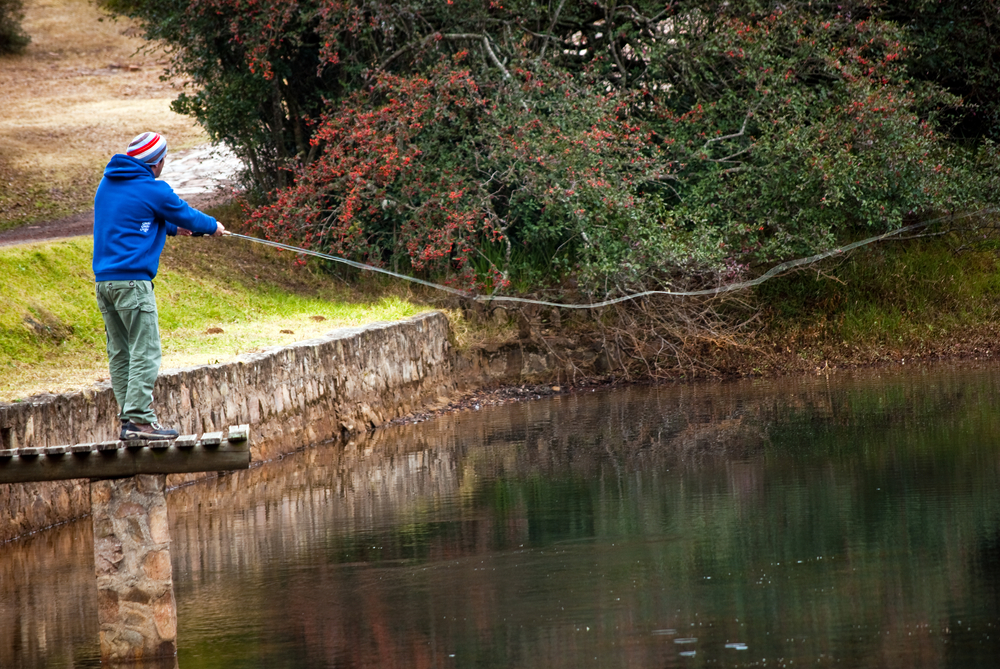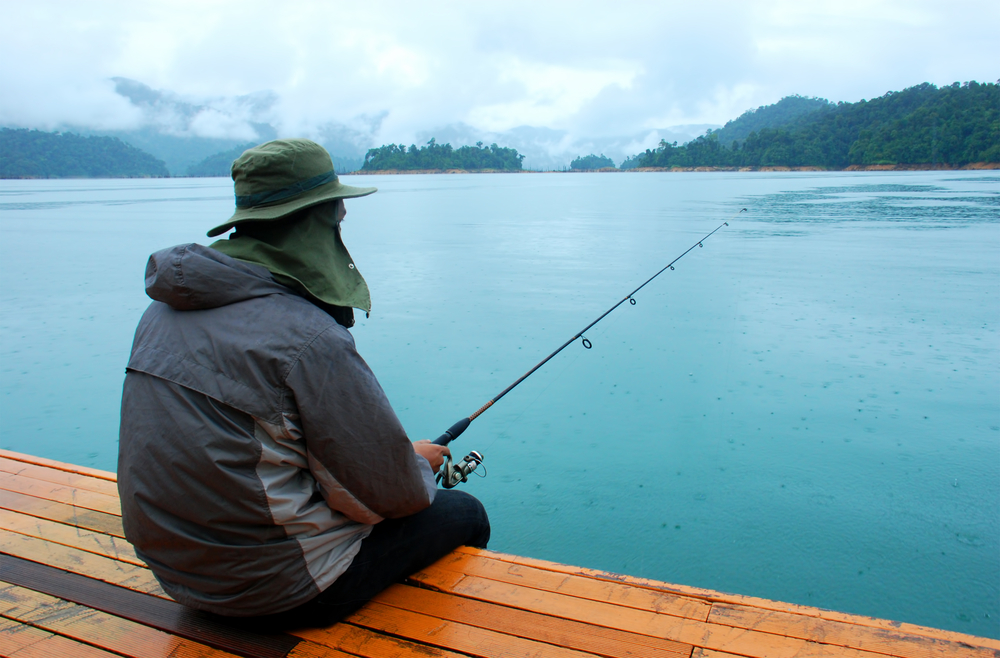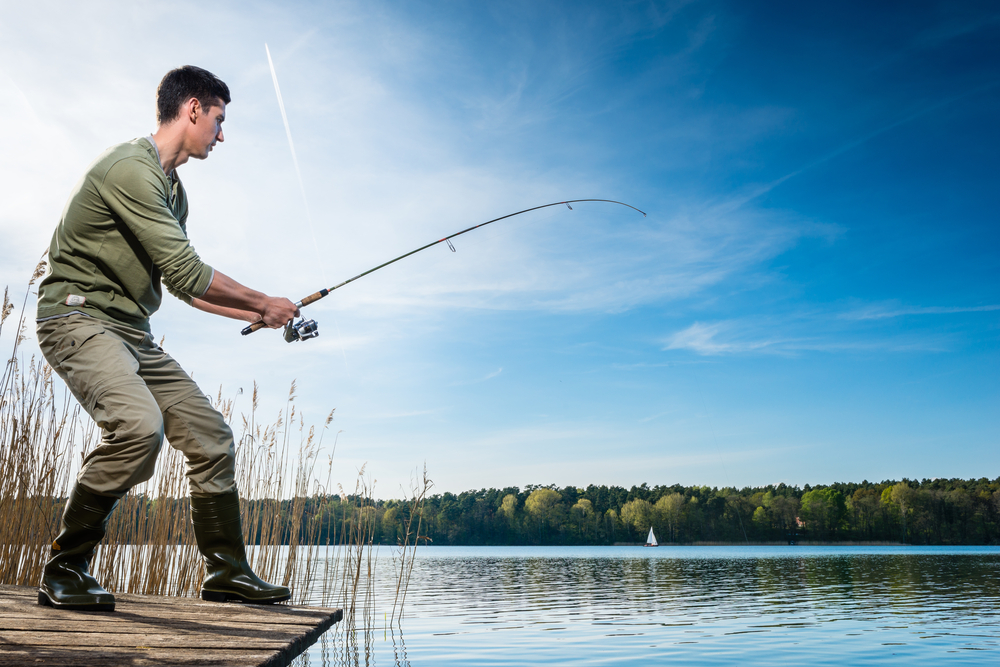When I was in high school I aspired to be a jock. The allure of receiving instant credibility from my peers for my accomplishments in my sporting endeavors or impressive feats of athleticism was always a thrill. I can remember newspaper clippings, scrapbook pictures, and still photos that captured all of the historical moments. But those days are behind me now and as I look back on the memories of dashing touchdowns, blazing fastballs, and cheering fans, a new playing field has emerged.
For many of us more sophisticated and intricate devices have now replaced the tools of our youth. For many of us the long rod has now become our first love and the aspirations of being a different type of jock embellish our consciousness.
This jock sometimes puts all reason aside and accomplishes a physical feat that is truly worthy of being any scrapbook photo or instant replay. Precariously teetering from above King Neptune’s abyss these jocks manage to make their claim to fame when that trophy linesider or other scaly predator slowly slides upon their mossy perch. You know this person; they are the jetty jock.
The beaches along the New Jersey coastline are well known for their jetty construction. They provide the perfect playground for those who want to play the game, those who are undeniably motivated to pursue their passion of jetty hopping. But not knowing the rules can quickly take any jetty jock from the playing field to the sidelines in a hurry. For the fly fisherman this is no exception.
Many fly fishers may look upon a jetty as an insurmountable barrier, a treacherous place where tales of mysterious mishaps keep men from returning home from the sea. But with a little knowledge and fishing expertise these obstacles can be quickly overcome. There are certain details you will need to know and certain rules that you will have to play by. From my perspective, the fly fisher, especially the neophyte, is going to require a little jetty knowledge before shooting a line into the suds. So now that my little bit of fun and exaggerated writing is over here’s what you will need to know.
In General

Jetties provide an avenue for the fly fisher to hook into fish that ordinarily would be unreachable from the beach. In many parts of New Jersey the beaches are literally littered with groins about every two hundred yards or so. These areas provide excellent structure that attracts stripers, blues, weakfish and albacore of truly trophy proportions putting them just beneath your korkers.
The extensive crevices, hiding places, and myriad of marine life that is present around jetties establishes an ecosystem that is highly productive. The jetty becomes the great equalizer for the fly fisher by trapping bait along its sides, which inevitably lures in the predators. June is prime time to target and fish these structures as water temperatures are now in the low sixty-degree range. At this temperature stripers, blue, and weakfish will aggressively chase down and strike out at your flies.
The Real Name
By definition, a jetty is any long artificial structure built perpendicular to the coast to protect the openings of inlets, harbors, or inlets. A groin is a short artificial structure built perpendicular to the shoreline in an effort to control beach erosion by trapping sediments carried by longshore or littoral currents. If these currents are flowing from south to north along the beach than deposition of sand will occur on the south side of the groin and erosion on the north side.
It is common practice to use the term jetty to refer to all of the rock structures along the beach even though technically this usage is incorrect. The term groin is unfamiliar to most people and for the rest of this article we will use the word jetty when referring to the rock structures jutting out from our beaches.
Anatomy of a jetty
For the fly fisher understanding the anatomy of a jetty will help to address the issue of how to fish it properly and productively. There are three parts to any jetty: the beach end, the middle section, and the tip. All three regions have somewhat distinctive features and are fished with different strategies.
Most of the jetties in New Jersey have been constructed so that at mean high tide they will still be two feet above sea level and not become completely submerged. So even at times of high tide they are fishable. A storm or rough surf however will render them unsafe, as waves will wash over them sweeping even the most experienced fly fisher off of their feet.
Fly fishing a jetty can be compared to fishing an unfamiliar trout stream for the first time. The strategy is to read it. Work its entire length fishing both sides until you learn where the deeper holes and ambush points are located. A good rule of thumb is to fish the tip first, particularly in the early morning at sun up. This is where the largest fish will be located the majority of the time. This will make the tip a rather attractive place and will become crowded very quickly especially if there is easy access and parking available directly behind the jetty on the street.
Strategy: Tips on Jetty Tips
When working a jetty the fly fisher should be aware that rarely do jetties drop straight down. Storms, hurricanes and the like have taken their toll on them and have dislodged the jetty rocks spreading them out into the water. In some instances an additional seventy-five to one hundred feet can be hidden below the surface of the water. It is the very nature of this subsurface structure that establishes a prolific marine ecosystem that attracts bait and predators and in essence makes the tip so productive.
The tip of the jetty will give the fly fisher the ability to cast 180 degrees. One can fan out and work the rockpile from many different angles. The tip is most favorable at high tide when the water is relatively calm. In rough water conditions the tip will be unfishable due to large waves which will be breaking on top of it or pour large volumes of white water upon its face.
As with any part of the jetty when retrieving your fly it should be pulled directly to the edge of the rocks. Allow your fly to sit momentarily in a pocket of water next to the rocks undulating back and forth. Bass and blues will attack this fly in a last desperate attempt to capture its prey, as it appears pinned in with no escape.
Jetties were designed to prevent beach erosion but in hindsight we now realize that they actually cause more. This erosion is particularly evident at the tip. As the littoral current transports sand along the beach you will find that the jetty acts as a barrier trapping sand on the side of the jetty that the current is striking. This was the initial purpose of the jetty. It was hoped that this sand would build up and fill in the beach behind or in other words up current of the jetty.
However what is observed is that the opposite side of the jetty or down current side becomes void of any deposition of sand. As a result a deep hole develops on this side adjacent to the tip. This spot is a prime location for trophy fish to be lurking. It should be spotted quickly by the fly fisher and fished first before any other anglers have a chance to toss in an offering
Pay particular attention to this spot if the wind is blowing and pushing waves into this hole. This will trap plankton and draw bait into these quarters making it an easy prey. Don’t pass up this opportunity when the conditions set up in this manner. It will be an excellent ambush point with highly productive results. Keep in mind too that the natural downwardly sloping beach topography also contributes to making the tip deeper than any other part along the jetty.
In rough water conditions the tip may be unfishable due to large waves that can be breaking on top of it or pouring large volumes of whitewater upon its face. If you underestimate the potential of an oncoming swell you can easily be swept off of your feet. In situations that are questionable it is better to err on the side of safety. At all other times make sure that you have on a pair of korkers to ensure good footing. For the most part the ideal line to use when fishing any section of the jetty will be an intermediate sinking line. Because the intermediate line has a sink rate of one to two inches per second it will present the least opportunity for getting hung up. This line will be your workhorse line in moderate to slightly rough surf.
The exception to this rule will be when working the trophy hole at the tip. If this line fails to draw any strikes I would switch over to a sinking line before abandoning the hole. A sinking line, depending on its weight, will sink at the rate of five to nine inches per second. Allow this line to sink down to various depths in the hole experimenting with different retrieves. A jerky strip and sit type of retrieve will usually produce powerful strikes.
Strategy: Middle Section

After feeling comfortable that you fished the tip exhaustively you can now move to the middle section or beach end of the jetty. The choice will be up to you. Both areas are conducive for holding bait and will produce fish. If you move to the middle section look for out croppings of rocks with sheltered cove-like features in their centers. These may to be difficult to recognize for the beginner because sometimes these changes in rock structure are slight and hard to notice. You will need to remember that what you see on the surface extends out and continues well below the surface. A small outcropping above will increase in size and length below the water. Here is where polarized sunglasses will aid the fly fisher. The glasses will allow you to see below the surface as they eliminate glare.
One of the most predominant features of the middle section of the jetty will be the presence of rip currents, which will run along its sides. The edges or tail out sections of rips are excellent places for trophy fish to lie in wait for an easy meal.
Rip currents can develop in two ways. Rip currents along beaches will develop when water rushes seaward from the beachface with enough force to break through a relatively unstable sandbar. Along the sides of jetties rips will develop as water moving laterally along the beach is redirected by jetty. The jetty is an obstacle that the water needs to go around. As a result deep cuts will be carved along the sides of the jetty rocks as the water follows it path of least resistance.
Fishing these rips will undoubtedly put you into fish. To fish the rip from the middle section, cast your line into the beach allowing it to fall on the backside of an advancing wave. As your line is swept out allow it to sink until your line is out in front of you at about the one o’clock position. At this point start stripping back slowly letting the naturally flow of water over the fly produce undulations. Do not strip to quickly or your fly will rise to the surface taking it out of the strike zone.
Another very effective method to fishing this rip is to dead drift your fly through it. Cast in the same manner as before but as your fly is swept out feed line to the fly. This will allow the fly to be swept out towards the tail section of the rip without rising to the surface. As your line begins to straighten at the end of the drift start to strip, be alert for a quick strike as soon as the fly is pulled towards you.
A strong current will necessitate the need for a sinking line in order to fish the rip effectively. Keep as much line off of the water to prevent a belly in the line as it drifts. Hold your rod tip up slightly as the line is fed out. Maintaining contact with your fly will be the key to hooking fish or missing them when they strike.
Strategy: Beach End
The beach end of the jetty will run all the way back to the zero line which may be the street, dunes, or a permanent bulkhead. The majority of this portion is covered with sand and never seen. This gives the illusion that the jetty ends where it meets the waterline on the beach.
As you move to the beach end of the jetty you will usually find a pocket where the beach and jetty meet. This spot will warrant close examination, as even large predators will frequent this spot. Don’t be fooled into thinking that the shallowness of the water in this area is not a prime fish holding region. As a matter of fact it is quite to the contrary.
As water rushes back from the beach it will churn up sand in the region known as the beach scarp. This is the region that lies directly in front of you as you enter the water. A drop-off is usually produced from the seaward returning water that will dig out the sand in this area. This trough will serve as an avenue for cruising fish looking for small invertebrates, which are being dislodged by the waves churning action. You will also find that small baitfish will use this area as they follow the topography of the coastline on their migratory routes.
After you work the beach end pocket fish this trough by casting straight out from your position. Allow the incoming waves to push your line into this trough and then retrieve back slowly directly towards you. Any hook-ups in this area will allow you to quickly get off the rocks and on to the beach to fight the fish.
Fish Fighting Tactics

Special consideration should be given to fighting fish from the middle or tip section of the jetty. Any large trophy size fish will necessitate the need to get off the rocks to land the fish or for that matter at least have a predetermined landing route. Walking a fish off of the rocks and landing it in the surf will be safer than risking having to climb down the rocks and being knocked off of the jetty by an unsuspecting wave.
If the fish will not allow you to move off of the rocks because of its size, look for a flat rock near the waters’ edge or a cove-like indentation amongst the rocks where the fish could be led and slid onto. This will minimize the chances of your leader getting cut on the rocks as you get ready to land the fish. Be ready for one final desperate attempt by the fish to escape as it realizes the end is near.
A common mistake that is made by many beginners after they have successfully walked a fish off of the rocks is to immediately begin reeling the fish in while standing next to the jetty. To eliminate any chance of the fish running back into the rocks the experienced angler will walk a good distance away from the rocks before any retrieving has begun.
As you walk down the beach your reel drag and rod bend should control the fish as line is stripped from the reel. As you apply pressure try to feel the direction in which the fish’s head is facing. Try to turn the head so it is facing the beach while guiding the fish to swim away from the rocks. Once you are a good distance away from the jetty you can continue to fight the fish in a normal manner.
Leader Tip
It is important that you taper your leader when fly fishing from a jetty from a heavier butt section down to a lighter tippet. The reason for the heavier butt section is two fold. First the heavier butt section will give you added protection from a break-off when a hooked fish decides to run across the rocks in an effort to break you off. Bass in particularly are known to do this and do so more by design than by chance.
The second reason for the heavier butt section is that it will be beneficial when you need to grab your leader to land a fish. Many times you will need to reach out and grab your leader to pull the fish close enough to land. The heavier butt section will be more comforting on your hands than a much lighter section of leader material. This will be especially true if you need to lift the fish slightly onto a rock.
Your butt section can be a two to three foot section of thirty or forty pound hard mono. For your tippet section I would recommend staying slightly on the heavy side with twenty pound. For an intermediate line you can taper from 30-25-20 pound for a good set-up with an overall length of eight feet. You will also find that tapering in this manner will better help to turn over your fly.
Jetty Safety
Enough can’t be said about always keeping safety first in mind when fishing any jetty. You need to be aware of difficult rocks to climb and the spacing between the jetty rocks as you walk out on them. Korkers will be a must but most anglers fail to realize that korkers grip best on wet rocks. These carbide steel studded sandals do not grip well on dry rocks. In fact you will have a tendency to slip or slide on a dry rock if you jump to one that is on an angle.
Make sure that the korker you select for your boot does not extend being its toe. If it does it is the wrong size. It is too big. Your korker should come up to the toe or just short there of. Also check your studs regularly and replace any that have fallen out or are worn. If the stud is worn down to the point that it is rounded out it is no good, it will not grip. You can even add extra studs for better footing if you like.
When fishing you should also be aware of any rogue waves that can quickly appear if a swell is present. These waves can quickly wash on to the jetty and sweep you off of your feet putting you in a rather precarious situation. Always have one eye on your line and the other on the incoming waves.
The safest attire that you can wear on the rocks in rough weather conditions is bibs, knee high boots with korkers, and a rain jacket. Wearing waders on a jetty is not advisable. The bibs will give you more mobility on the rocks and if and you were to take an unfortunate spill into the water it would much easier to make your way back onto the rocks in them. With waders they would fill up with water and become very difficult to maneuver in. They would not as many believe cause you to sink or pull you down. Not knowing how to swim does that.
The only time I will wear waders on a jetty is if I am fishing a stretch of beach that I am jumping from the rocks to the beach and back to the rocks as I work its entire length. In Monmouth County in particularly one can find many jetties in a stretch of beach that is a mile long. Here wearing bibs and knee-high boots would not be practical while I wade into the suds. This would only result in the boots filling up with water.
If you use your head while on the rocks you shouldn’t take a spill into the drink so waders have their place as mentioned above. However, don’t wear your expensive breathables if you are going to jetty hop because they will not hold up if you rub them against the rocks, barnacles, or mussels that can be found there. Rather I have a pair of canvas waders that I have reserved for just this purpose. They will hold up better and resist tears and abrasions.
Nighttime Safety Tips

Nighttime can be a very productive time to fly fish from a jetty. This will be particularly true later this month and through the rest of the summer as our bass move more into their nocturnal feeding mode. A word of caution however should be emphasized here if you plan to venture onto any of these rockpiles.
First, going out on an unfamiliar jetty at night is not advisable. The nighttime is not the time to explore a new domain. Stick with jetties that you are thoroughly familiar with and know what to expect when it comes to the rock formations.
Secondly, always go with a partner. This way if something unexpected happens someone will be there to help you. And thirdly, make sure that your flashlights are bright and in good working order. Trying to scamper back in from a jetty tip in the dark if your light fails is not going to be fun.
Finally, if you do venture out alone make sure you plan an itinerary and leave it with someone so that they will know where you will be, at what times, and when you plan to return home.
So there you have it. Some knowledge and strategies to get you started or improve your tactics when confronted with this ominous rockpile we call a jetty. If you play by the rules you can reap the rewards of a trophy fish and maybe even bestow upon yourself that coveted title of…jetty jock. Good Fishin!…Fly fishing that is!









